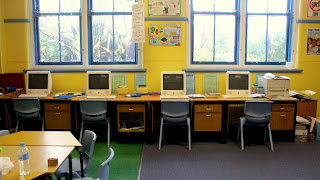I have amazed myself at what I have learnt and produced over this semester, such as making my own podcast, digital stories, and blogs. I will not waste what I have learnt this semester, as I will continue to immerse myself in learning teaching technologies and document it in the form of an e-portfolio. Mason et al (2004) define e-portfolios as ‘self-selected multimedia presentation of student work that offers a rich and textured view of a student's learning and development’. Not only will it be something to be shown to future employers, but it will be a great sense of pride and accomplishment for myself.
During my Prac at Botany Public School, I was fortunate enough to incorporate learning technologies in the classroom, in the form using the interactive whiteboard (see blog post ‘Time to Teach’ and 'Second Week at Botany Public') It was during this experience that I realized how important constructionist learning was (see blog post ‘Children Constructing their own Learning’). Papert and Harel (1991) describe constructionism in its’ simplest form as “the idea of learning-by-making”. I discovered that greater and more enriched learning took place when students actually constructed and built their own learning, rather than me simply trying to ‘instruct’ them through it using the interactive whiteboard.
In the last half of this semester during tutorials, we began looking at ethical issues, such as cyber-safety and cyber-bullying. This is such a serious issue, and we as pre-service teachers need to be aware of the negative implications of integrating technology into our classrooms. (see blogpost ‘Fighting a lost battle?’) Sharples et al (2008) state that schools have a role in educating children how to use the internet safely and responsibly, and I believe that as technology advances, this role is to become much more important. After all, what is the point in teaching using technology, when students are placed at risk?
This subject has both enlightened me, and inspired me to incorporate learning technologies in the classroom, in a constructivist approach. I aim for my classroom, no matter what the technological divide, to have a balance in using traditional and technological teaching methods, but more importantly, to engage students in a myriad of opportunities to create, construct and build their own learning.
References:
Mason, R., Pegler, C.,& Weller, M. (2004). E-portfolios: an assessment tool for online courses [electronic version]. British Journal of Educational Technology, Vol 35 No 6.
Sharples, M., Graber, R., Harrison, C., & Logan, K. (2008). E-Safety and Web 2.0. Retrieved on June 14, 2010 from the UTS Online Website: https://online.uts.edu.au/courses/1/012233/content/_584164_1/web2_esafety.pdf?bsession=39913759&bsession_str=session_id=39913759,user_id_pk1=244235,user_id_sos_id_pk2=1,one_time_token=
Papert, S., & Harel I. (1991). Situating Contructionism. Retrieved April 22, 2010 from the Papert Website: http://www.papert.org/articles/SituatingConstructionism.html.








 This tale tells the story of a unique zebra who has lost his herd! Help Roy find his herd!
This tale tells the story of a unique zebra who has lost his herd! Help Roy find his herd!










